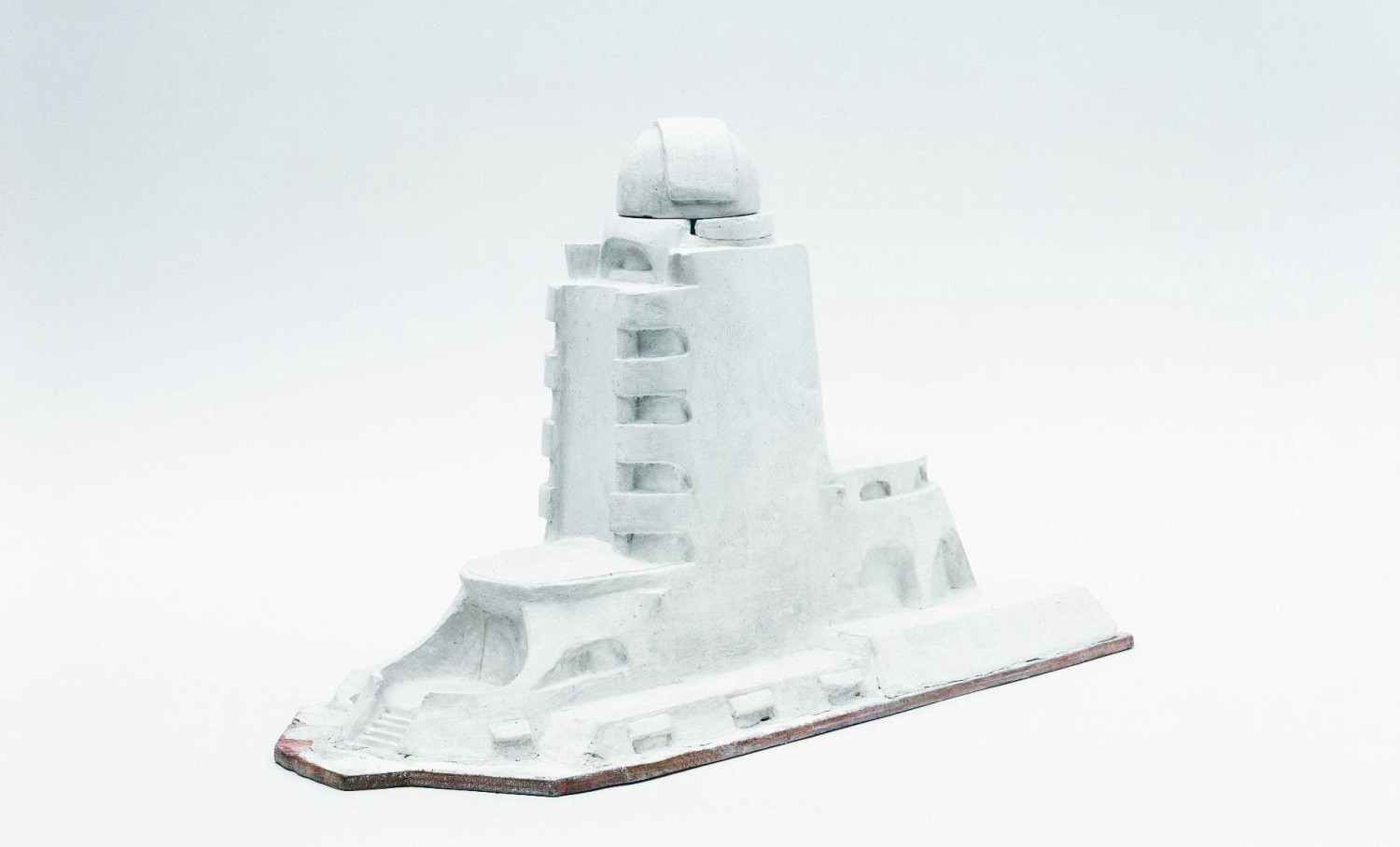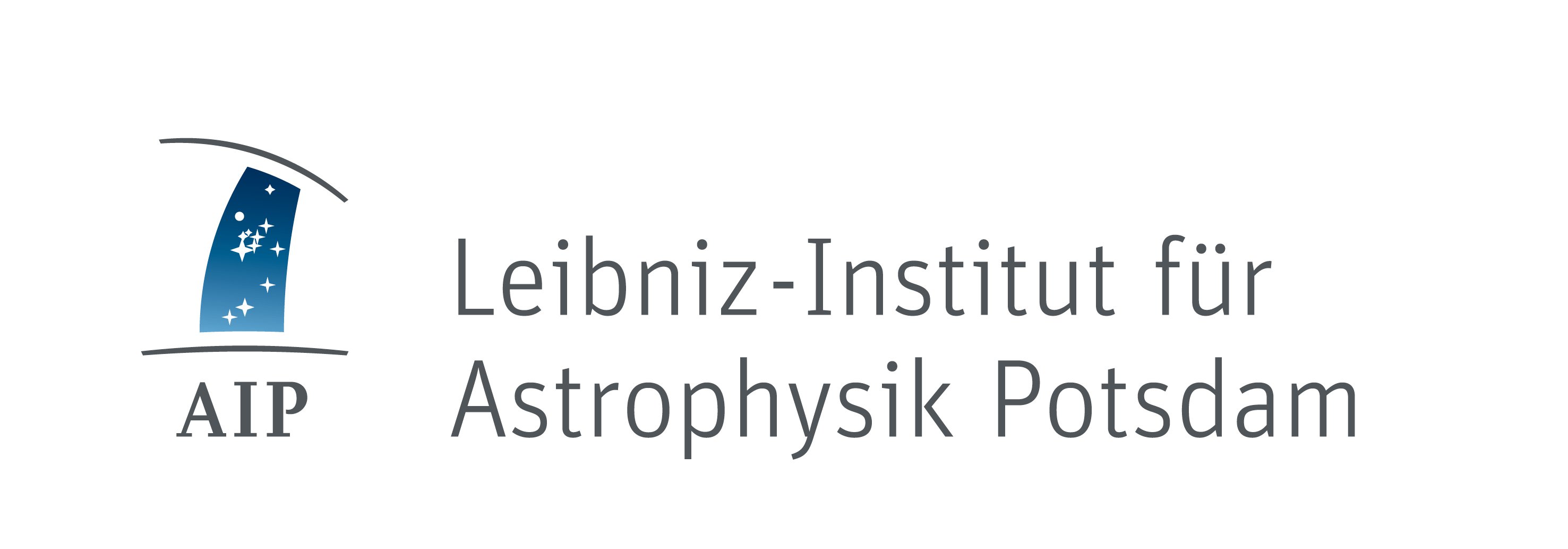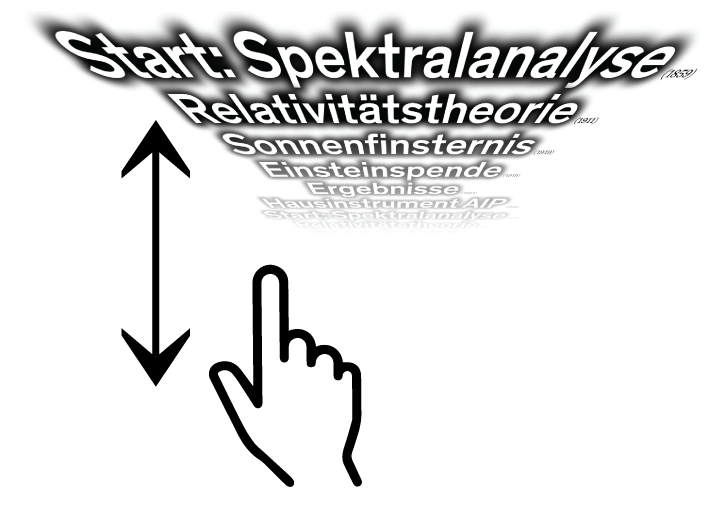“I have no faith in the Germans” (Erich Mendelsohn in a letter to Luise Mendelsohn dated 28 June 1922).
The Einstein Tower came into being in unique historical circumstances and its realisation was made possible by the convergence of a range of different people, including Albert EinsteinAlbert Einstein (1879–1955) was one of the most important physicists in the history of science. He began developing the theory of relativity in 1905. In 1914 he joined the Prussian Academy of Sciences and in 1917 became director of the Kaiser Wilhelm Institute for Physics, which had been founded for him as a means to support his work. He won the Nobel Prize in 1921 (awarded in 1922). He spent periods teaching and conducting research in the USA. In 1932/33 he went to Princeton, never to return to Germany. He was clearly opposed to Nazi Germany and did not renew his ties with the country, even after 1945. He retired in 1946 and continued his work as professor emeritus at the Institute of Advanced Studies in Princeton., LuiseLuise Mendelsohn, née Maas (1894–1980), studied cello in London, Leipzig, and Berlin. She met Erich Mendelsohn in 1910 and married him in 1915. Their daughter Marie Luise Esther was born in 1916. She abandoned her musical career and supported Erich when he started his own practice. Many of Erich’s jobs, including the commission for the Einstein Tower, can be traced back to the network Luise established. After the Mendelsohn family were forced out of Germany by the Nazis, Luise secured many new commissions for her husband. After Erich’s death, she organised his estate. and Erich MendelsohnErich Mendelsohn (1887–1953) studied architecture at the Charlottenburg (Berlin) and Munich universities of applied sciences. He married Luise Maas in 1915. After returning from the First World War, he founded his own practice in Berlin – it became the best-known and most successful architecture office in Germany. In 1933 he emigrated to England, before moving to Jerusalem in 1939 and then to the USA in 1941. He built important works in all these countries., and Erwin Finlay FreundlichErwin Finlay Freundlich (1885–1964) was an astrophysicist. In 1910 he became an assistant at the Berlin Observatory. He joined Einstein’s Kaiser Wilhelm Institute for Physics in 1918, becoming its first member of staff. He drew up plans for the Einstein Tower, which was to be the most powerful solar observatory in Europe. He was made director of the Einstein Tower in 1920. He was expelled by the Nazis and became a professor of astronomy in Istanbul. He was offered a professorship at the German University in Prague in 1936 and fled to Holland in 1939. He then took up a post at the University of St Andrews in Scotland, where he established an astronomy department, together with an observatory. He became Napier Professor of Astronomy in 1951.. The tower’s iconic design helped popularise the theory of relativity. It gave a visual anchor to an idea that defies our powers of imagination. As a result, the Einstein Tower and the theory of relativity made it onto the front pages of German magazines on several occasions. On 4 September 1921, the weekly newspaper Berliner Illustrirte Zeitung, which had a high circulation, led with a photograph of the tower after the shell of the building had been inspected and approved, with construction equipment still visible in the picture. It was journalists too who came up with the simple formulation “Einstein Tower” as a substitute for the awkward official name “Tower Telescope of the Einstein Foundation”.
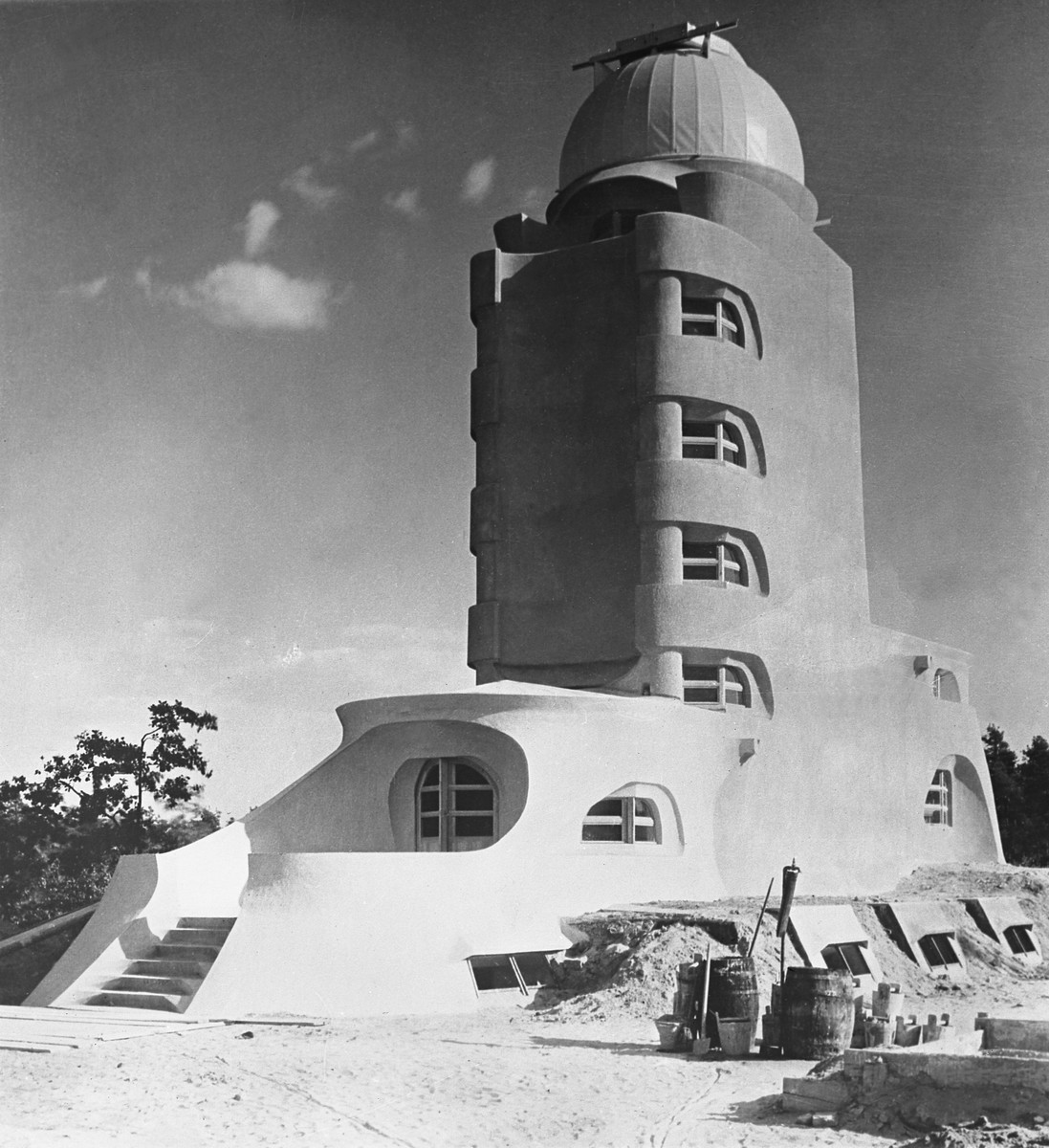
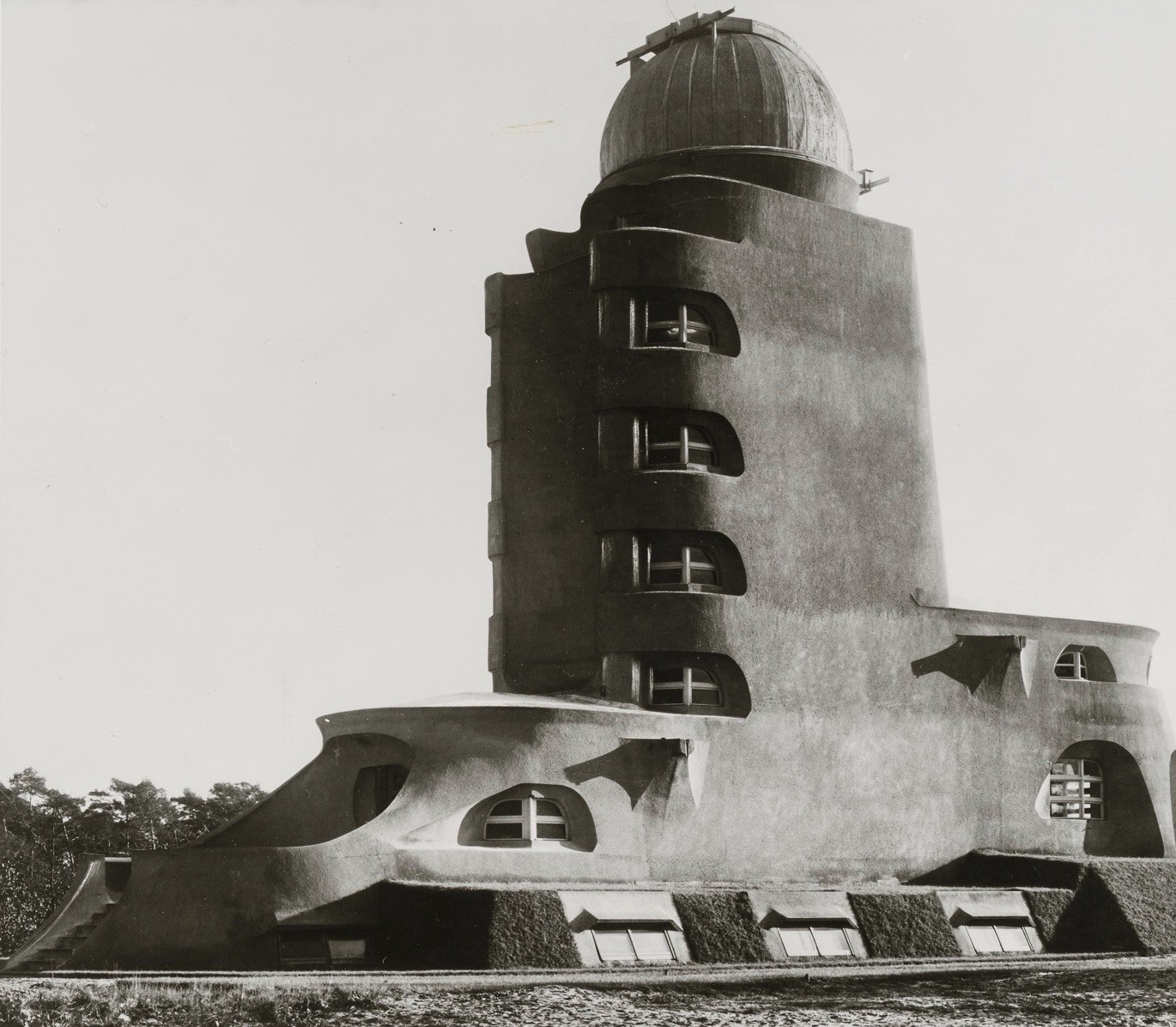
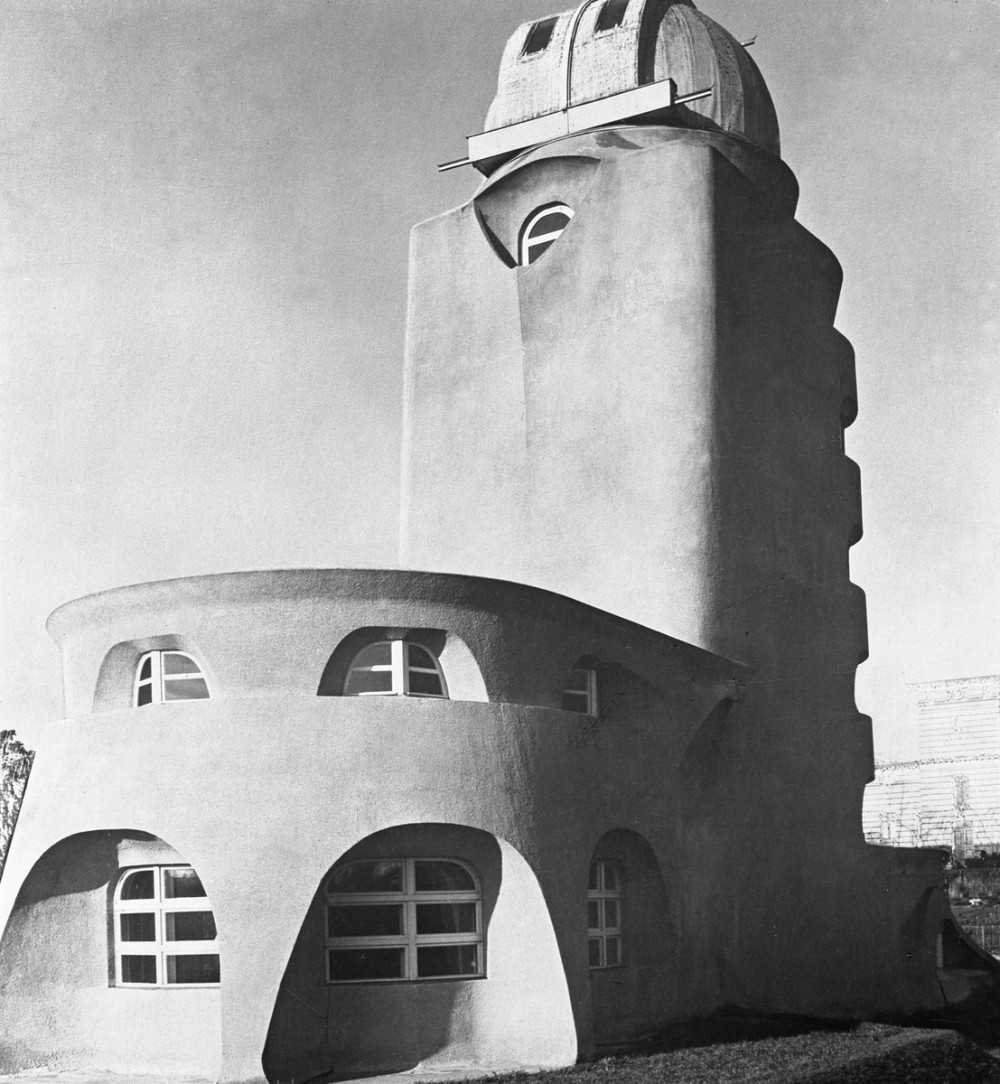
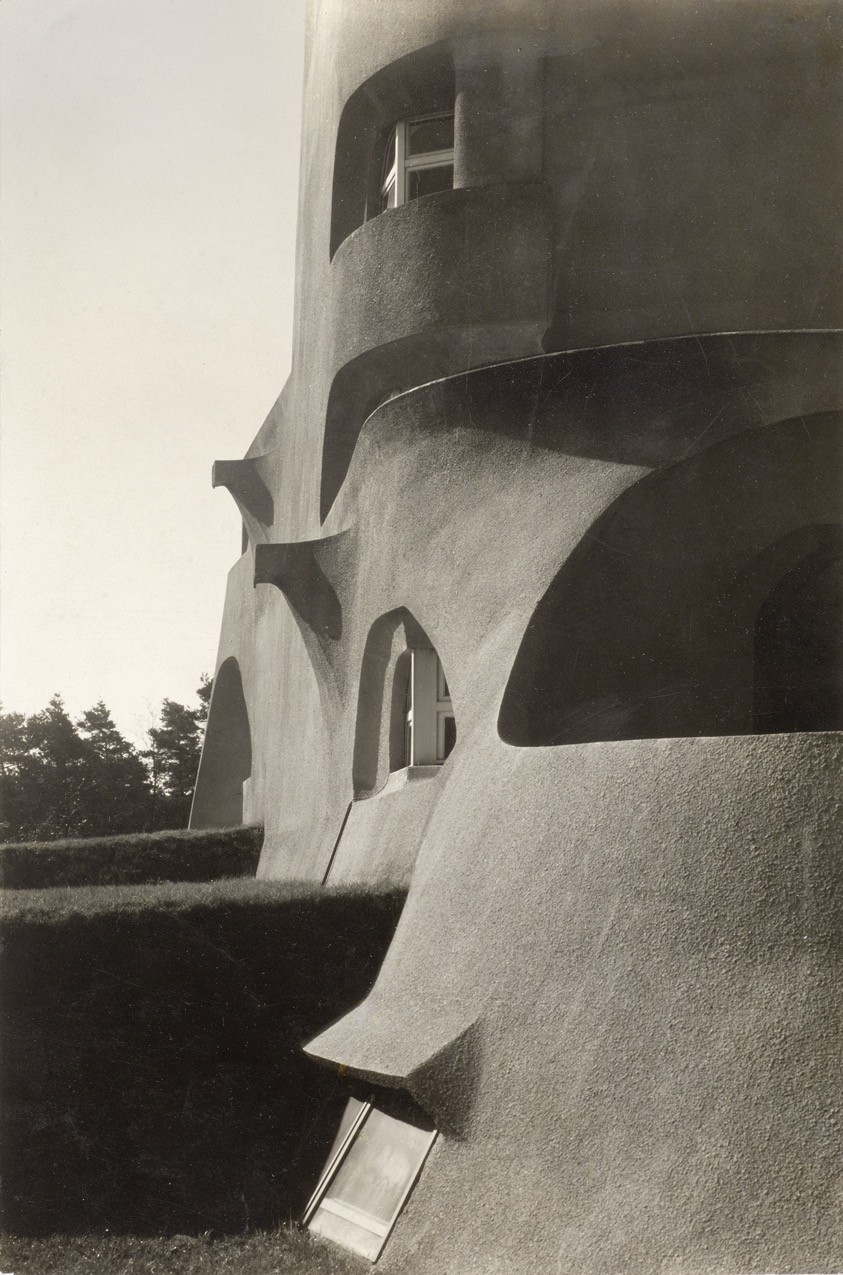
An unlikely success
It could certainly not be taken for granted that a piece of architecture that diverged in unprecedented fashion from everything that had gone before and a theory that called into question earlier knowledge of physics might develop such a wide appeal. The mood of the times was not attuned to the avant-garde, especially not in Potsdam. In 1920, the sons of the Kaiser, who had in fact just abdicated, inaugurated a monument to the 1st Guards Uhlans Regiment in Potsdam, an arch-conservative memorial that glorified war. A year later, also in Potsdam, 200,000 people attended the funeral of the former Empress Augusta Viktoria, who died on 11 April 1921. Prior to her burial, her body had been conveyed in state to Potsdam from her place of exile in the Netherlands, carried on a tide of reactionary sentiment. The resounding success of the Einstein Tower, which stood on every level for critical thinking, international cooperation, and new departures, was the antithesis of the nascent authoritarian spirit in Germany, which was beginning to burgeon, or perhaps had never been smothered.
The Einstein Tower as a magnet for tourists
The Einstein Tower was such an overwhelming popular success that tourists from England and the USA soon came to view the tower. These groups were shown around the tower by Harald von KlüberHarald von Klüber (1901–1978), astrophysicist, studied with Max Planck and Albert Einstein in Berlin. He joined Freundlich’s team in 1923 and was instrumental in getting the Einstein Tower’s scientific equipment up and running. In 1946 he became director of the solar physics department. In 1948 he joined the Arosa Observatory at ETH Zurich, and in 1949 he took up a position at the Cambridge Observatory in England, becoming assistant director there in 1961. He studied solar corona and made multiple expeditions to view solar eclipses all over the world., who was an ideal guide because of his good knowledge of English. In 1970 he wrote to Luise MendelsohnLuise Mendelsohn, née Maas (1894–1980), studied cello in London, Leipzig, and Berlin. She met Erich Mendelsohn in 1910 and married him in 1915. Their daughter Marie Luise Esther was born in 1916. She abandoned her musical career and supported Erich when he started his own practice. Many of Erich’s jobs, including the commission for the Einstein Tower, can be traced back to the network Luise established. After the Mendelsohn family were forced out of Germany by the Nazis, Luise secured many new commissions for her husband. After Erich’s death, she organised his estate. (now Louise) reflecting on this time: “I soon had to discover that to my slight disappointment the interest of the visitors was not so much captured by the interest for astronomy or as a matter of fact for Einstein’s famous theory, as l had hoped for. The visitors wanted to see the new interesting and controversial building and its famous architecture. Eventually, and in order to make the best of the situation, I learned to turn my usual explanatory talk from modern solar physics to one of comparative architecture” (Harald von Klüber in a letter to Louise Mendelsohn dated 4 November 1970).
This focus on form also characterised the tower’s reception among architectural experts, who rarely commented on its scientific functions, without which it would not exist and which Mendelsohn’s architecture was designed to serve right down to the tiniest detail.
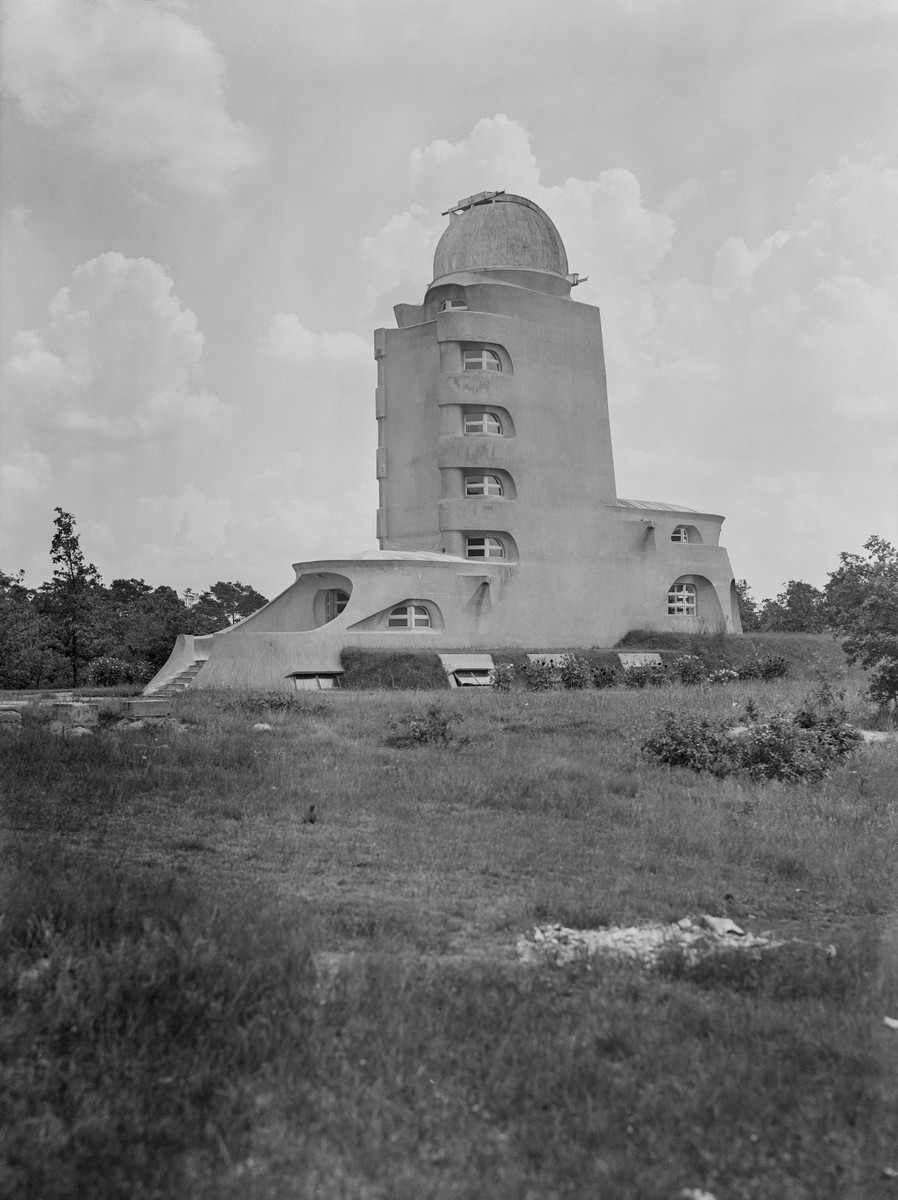
Reception among experts
Prior to the success his building enjoyed in the general press and long before its completion, Erich Mendelsohn had succeeded in publicising the Einstein Tower in professional circles in a way that was rare at the time for a work that did not yet exist. In 1919 Mendelsohn exhibited some of his sketches – including drawings of the Einstein Tower – at Paul Cassirer’s gallery in Berlin. The exhibition, which was entitled Architektur in Eisen und Beton (Architecture in Iron and Concrete), travelled to Hanover, Hamburg, Breslau, Chemnitz, Stuttgart, and Cologne. Over the next few years Mendelsohn would receive building commissions in four of these six cities as well as in Berlin. An example here is entrepreneur and publisher Salman Schocken, who saw the exhibition in Berlin and went on to become one of Mendelsohn’s staunchest clients.
As a result of the exhibition, an entire issue of the influential Dutch architectural magazine WendingenWendingen (= turns or upheavals): Architectural magazine edited by Dutch architect Hendrik Wijdeveld and published from 1918 to 1933. Wendingen had a major influence not only on the development of expressionist architecture but also on other architecture and art magazines and on contemporary book design. was devoted to Mendelsohn. One of the buildings the architect showed in this issue was the Einstein Tower, which was still known as the “Tower Spectrograph”. When the magazine’s deadline for submissions came around, construction work on the tower had probably only just begun, which is why he presented it in the form of a sketch and a model along with elevations and floor plans indicating the status of the approval plans. The issue was published in January 1921. There followed a host of other national and international reviews even before the building was inaugurated in 1924.

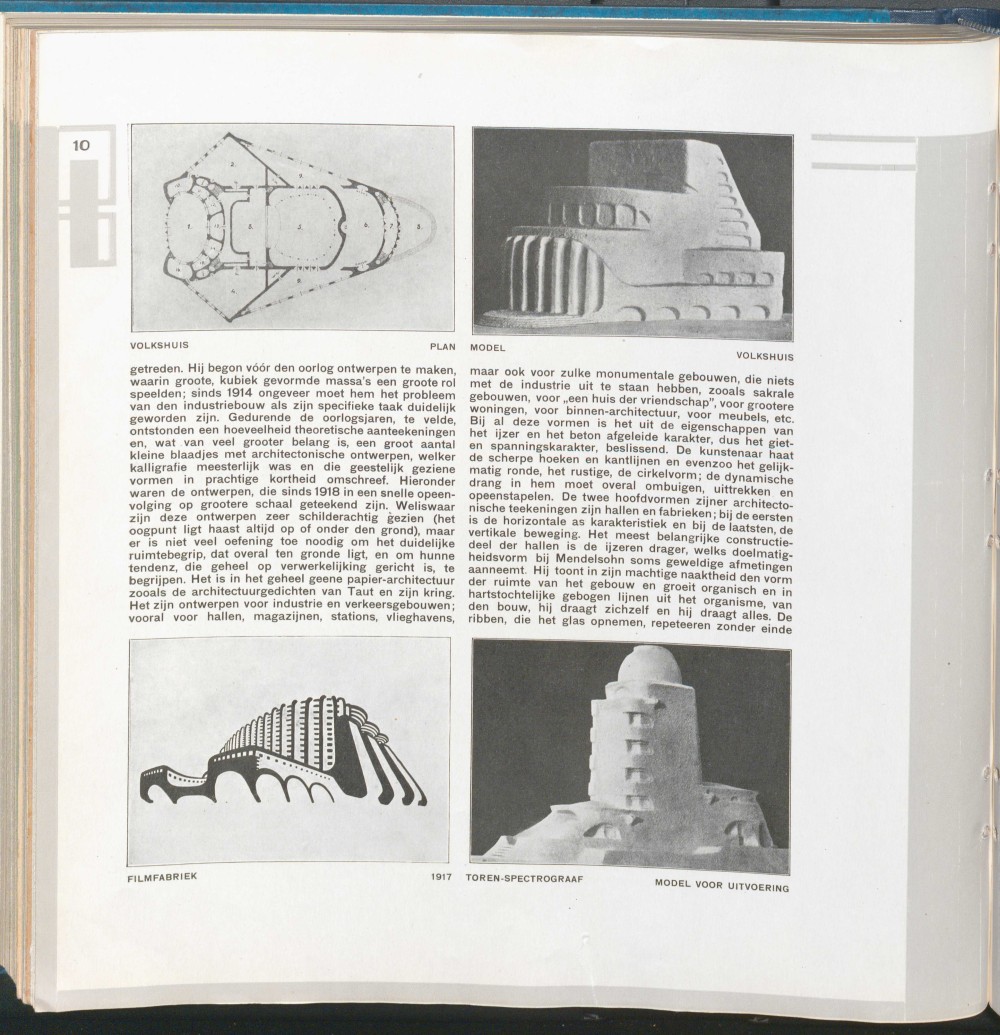

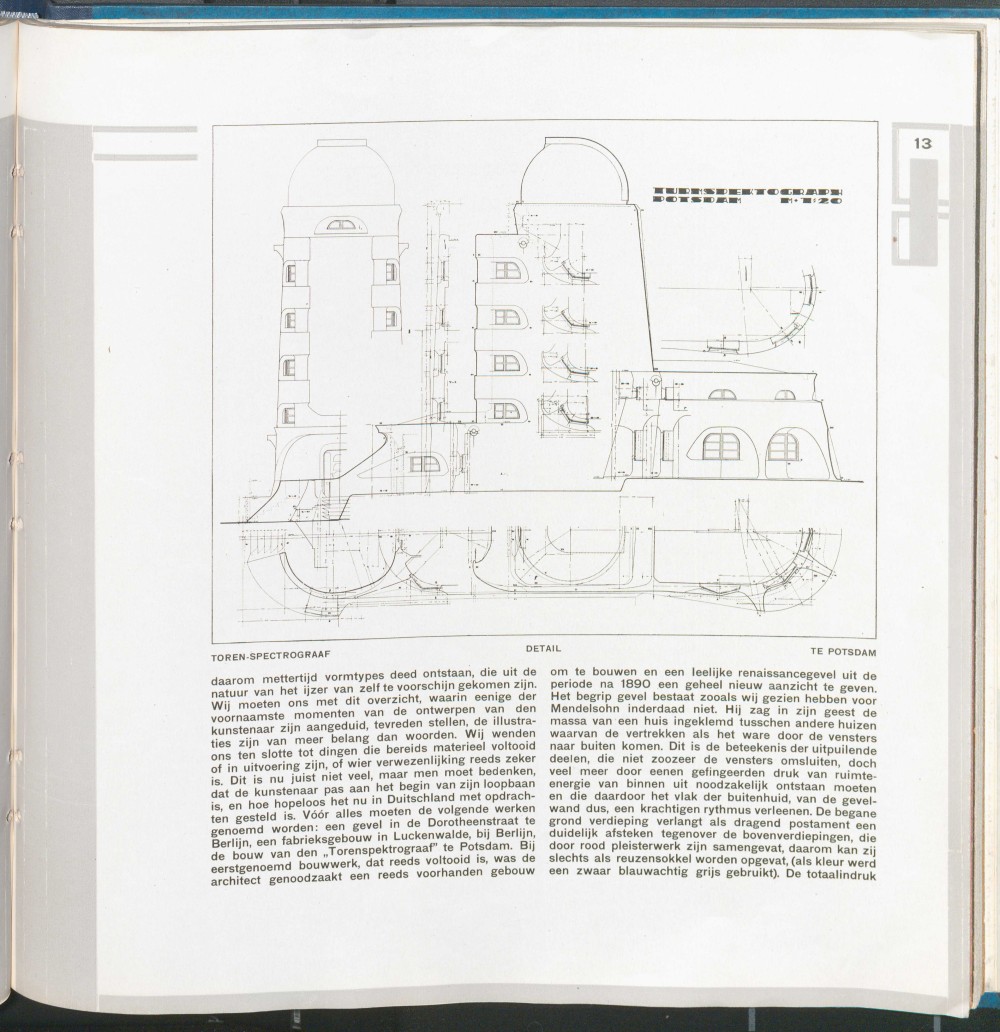
Success – and displacement
The Einstein Tower made Erich Mendelsohn not only one of the most famous German architects in the Weimar Republic but also one of the most successful – notwithstanding the years of crisis that followed the First World War. This success, which was also picked up on internationally, was to come to an abrupt end, in Germany at least. Luise Mendelsohn describes a key moment that helped bring down the curtain: “It was 21 March 1933: Erich’s birthday party was in full swing and the music was playing when Charles [du Vinage, Erich’s best friend and long-standing collaborator] came in. We both noticed his excitement and looked at him with a quizzical expression. The question on our minds was straightforward: What had happened? He began by apologising for arriving late: he had been in Potsdam to attend the rebirth of the Prussian army in the presence of Reich President Hindenburg. And then he said, with look of excitement on his face that beggars description, “I have seen the Führer.” His eyes were shining and he seemed moved to the core. It was the event of his life.… This experience with Charles du Vinage cast a pall over Erich’s last birthday celebration in Germany. It hastened our decision to quit Germany.” (Luise Mendelsohn: “My Life in a Changing World”, unpublished autobiography, quoted in Greenberg/Stephan 2004)
After leaving Germany, Erich and Luise Mendelsohn changed their first names to Eric and Louise. They went first to England, then to Palestine, then to the USA. Eric would continue designing buildings in all three countries – with the help of Louise’s contacts – and made a number of major contributions to the architectural history of the 20th century.
Canonisation and mystification
Nazism was to do lasting damage to the reception of Mendelsohn’s work, including the Einstein Tower. The Swiss architectural historian Sigfried Giedion, for example, makes no mention of Mendelsohn and the Einstein Tower in his 1941 reference work on 20th-century architectural history and theory, Space, Time and Architecture: The Growth of a New Tradition – a book that was based on his Harvard lectures – even though the title of the work would have immediately suggested its inclusion. Mendelsohn was piqued by this and wrote to Einstein asking what he thought of Giedion’s view of contemporary architecture, cubist art and the new understanding of space proposed by the theory of relativity, which the latter saw as parallel. Einstein replied with a quatrain:
“The new ’tis simple to advance
if any bunkum you will chance.
But rarer haps the moment, hence,
that newness rhymes with any sense.”
He recapitulated this with a brief remark: “It is just smart-arsery without any basis in reason!” (Albert Einstein in a letter to Eric Mendelsohn dated 13 November 1941)
It was not until 1953, in what was already the tenth edition of his book, that Giedion first mentioned Mendelsohn. Retrospectives of the latter’s work at Berlin’s Akademie der Künste (West) in 1968, at the Tel Aviv Museum of Art in 1979, and at the Berlin Kunstbibliothek in 1987 led to a veritable Mendelsohn revival. In the GDR era, Western scholars and architecture historians did not have easy access to his most famous work. The closest they could get to it, it would seem, was a plaster model of the Einstein Tower that was “discovered” in the 1980s by a gallery in Cologne. It was subsequently shown in two major exhibitions in West Berlin, the first of which stated that the date of the model was unknown, while the second, without backing up its attribution with further sources, placed it in the 1920s. With the help of prominent art historians (although still without any concrete historical evidence), the gallery then specified its date as 1919 and claimed that the model had survived the war in Tel Aviv. In the late 1980s, the Deutsches Architekturmuseum Frankfurt (DAM) acquired the model for the tidy sum of 100,000 Deutschmarks. In the 2010s, after detailed analysis of the sources and the materials used in the model, scholars at the DAM ascertained that it was a replica that could not have been made before the 1950s. The fact that the Einstein Tower has inspired the spinning of legends is due in no small part to its iconic formal language, which is open to interpretation. Or, as architecture historian Norbert Huse puts it: “The image created by Mendelsohn had gradually become an imago.” (Huse, “Facetten eines Baudenkmals”, 2000, p. 26)
